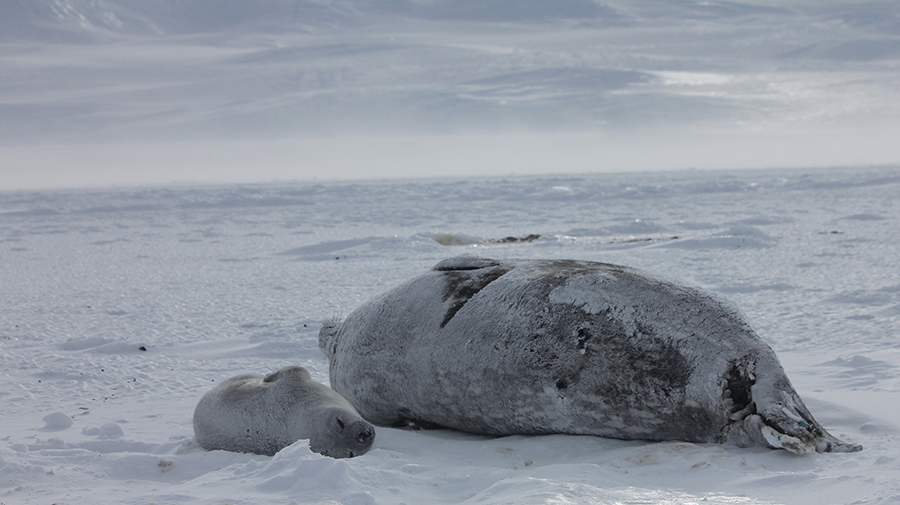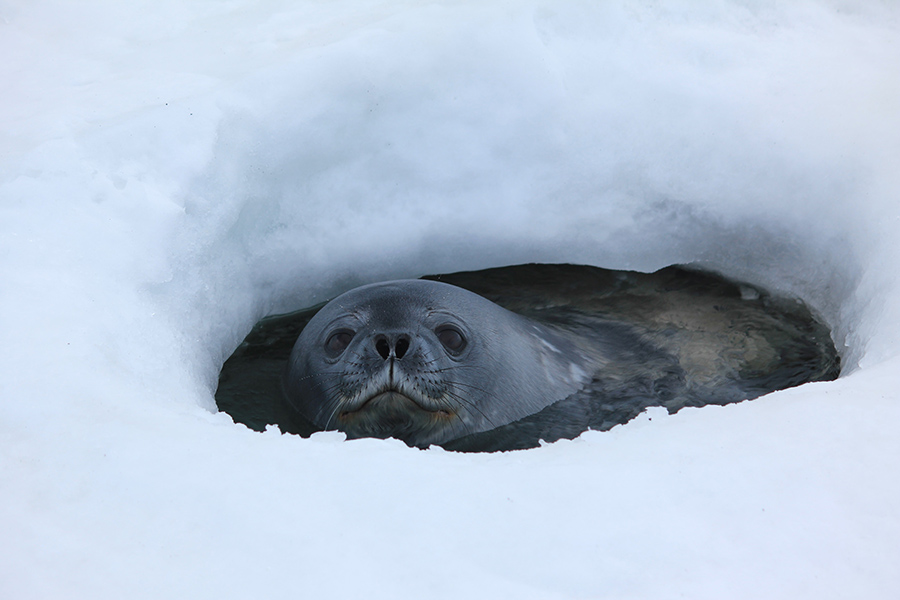|
Weddell seal pups learn to swim at an early age. Shedding fluffy baby fur shapes how Weddell seal pups learn to swimMolting determines when Weddell seal pups are ready for ocean life more than other factorsPosted June 06, 2022
Whether or not a Weddell seal pup is molting determines when they're ready to enter life in the water more than other developmental milestones, according to new research. 
Photo Credit: Linnea Pearson, NMFS Permit No. 21006-01, ACA Permit No. 2018-013 M#1.
A mom and baby Weddell seal rest on the sea ice.
A new study of Weddell seal pups in Erebus Bay, Antarctica finds molting status, rather than age or body mass, determines when a pup is ready to transition into adulthood. The results show pups who have finished molting are more prepared for life in the water than those who haven't. It's easier for pups with their adult fur coat grown in to stay warm in the frigid Southern Ocean, regardless of how much blubber the pups have packed on for insulation. “I don't think we expected the molt, specifically, to be as important as it turned out to be,” said Linnea Pearson, a biologist at California Polytechnic State University and lead author of the new study. “We really expected blubber to be more important rather than the actual shedding of the fur.” Interestingly, the results show pups learning to swim who were still molting spent more time in the water than those who were finished molting, even though they had to expend more energy to stay warm. Spending more time in the water may help them become more independent and better swimmers in the long run, according to the researchers. “Even though it's more [energetically] expensive to be in the water and on land while you're molting, it's also very important for them to gain experience diving and swimming and just being in the water,” Pearson said. “Being in the water itself will actually trigger physiological changes in the body to produce a better dive response, like increased blood volume and breath-holding ability.” Surviving a harsh childhoodResearchers have been studying Weddell seals, the southernmost breeding mammal, for over 50 years trying to figure out how the animals thrive in the frigid cold of Antarctica and the Southern Ocean. Pearson and her colleagues have spent several years studying how Weddell seals grow up and they particularly want to know how pups stay warm as they slowly build up their stores of insulating blubber. Female Weddell seals haul out of the ocean to give birth and nurse their pups on sea ice. But since seals spend most of their lives in the water, pups have to learn to swim early in life. Most pups enter the water around two weeks old, but some start when they're only a few days old. Pups that young aren't yet able to forage and find their own food, but gaining experience in the water - swimming, diving, and coming up for air - is critical to their growth and long-term survival. 
Photo Credit: Linnea Pearson, NMFS Permit No. 21006-01, ACA Permit No. 2018-013 M#1.
A Weddell seal pup peeks through the sea ice in Erebus Bay, Antarctica.
Weddell seal pups are born with a coat of fluffy fur called lanugo. As the pups grow, they shed their baby fur, grown in a new coat, and build up vast stores of blubber to keep themselves warm. The Southern Ocean has some of the coldest waters on Earth, but adult Weddell seals can spend up to an hour and a half submerged in those frigid waters thanks to their blubber. Unfortunately, pups have to get comfortable spending time in such cold water without the benefit of insulating blubber so they can learn to swim, dive, and find food. In the new study, Pearson and her colleagues wanted to know at what point a Weddell seal pup is ready to enter the water from an energy standpoint. Basically, at what point can the pups stay warm enough in the water to learn how to swim and dive, and what factors determine when they're ready? The researchers monitored Weddell seal pups in Erebus Bay, off the coast of Ross Island, from October to December of 2017 and 2019. They weighed and measured the pups, estimated their body composition (how much blubber they packed on), and used instruments to record how much time they spent in the water and how far down they dove. Researchers also measured the pups' resting metabolic rates and monitored their molting status. Swimming in the coldThe results showed pups who had finished molting expended less energy to keep warm in the water, regardless of how much blubber they had. This made sense to the researchers because one way mammals stay warm in a cold environment is by restricting blood flow to the skin and extremities. But molting seal pups can't do that because the hair follicles need a plentiful blood supply in order to grow their new fur coat. “We expected if they were fatter and had more blubber that they would be warmer in water regardless of what their fur looked like,” Pearson said. “But we found [molting] really mattered. Yes, more blubber is helpful, but they also needed to have a full juvenile coat and not be the fluffy, fuzzy little baby anymore.” The researchers also saw that on average, pups who had finished molting dove nearly twice as far down into the water as pups who were molting or had yet to molt. But surprisingly, molting pups spent on average more than twice as much time in the water in their first two months of life than pups who had finished molting. So pups who learn to swim while molting may be better prepared for life in the water in the long term, although the researchers can't draw definitive conclusions just yet. “There is an energetic trade off there, but being a good diver and getting all that physiology is very important and worth the cost of being in the water when they're molting,” Pearson said. This research is supported by the National Science Foundation, which manages the U.S. Antarctic Program. NSF-funded research in this story: Heather Liwanag, California Polytechnic State University, award 1543539. |
"News about the USAP, the Ice, and the People"



For USAP Participants |
For The Public |
For Researchers and EducatorsContact UsU.S. National Science FoundationOffice of Polar Programs Geosciences Directorate 2415 Eisenhower Avenue, Suite W7100 Alexandria, VA 22314 Sign up for the NSF Office of Polar Programs newsletter and events. Feedback Form |

